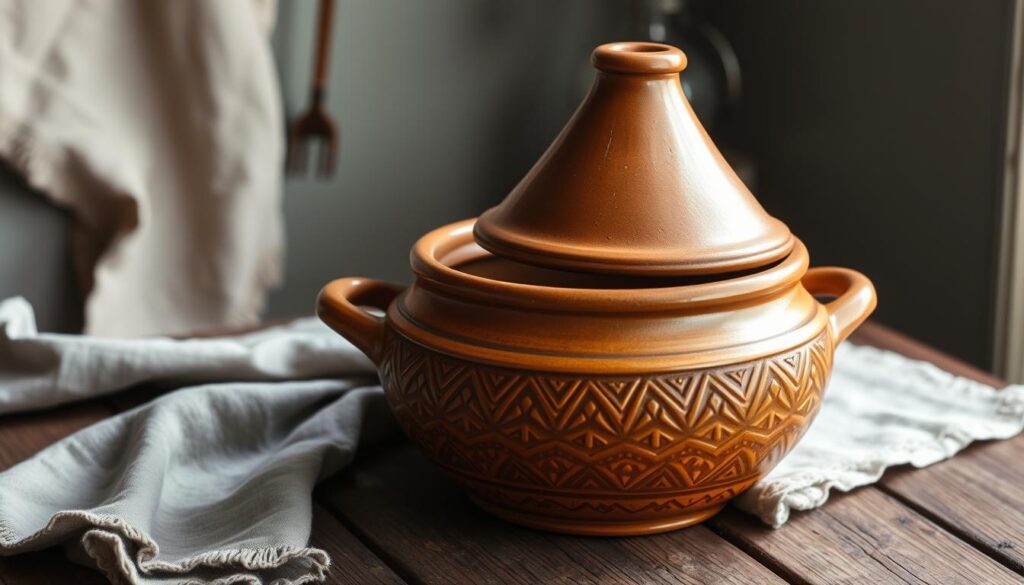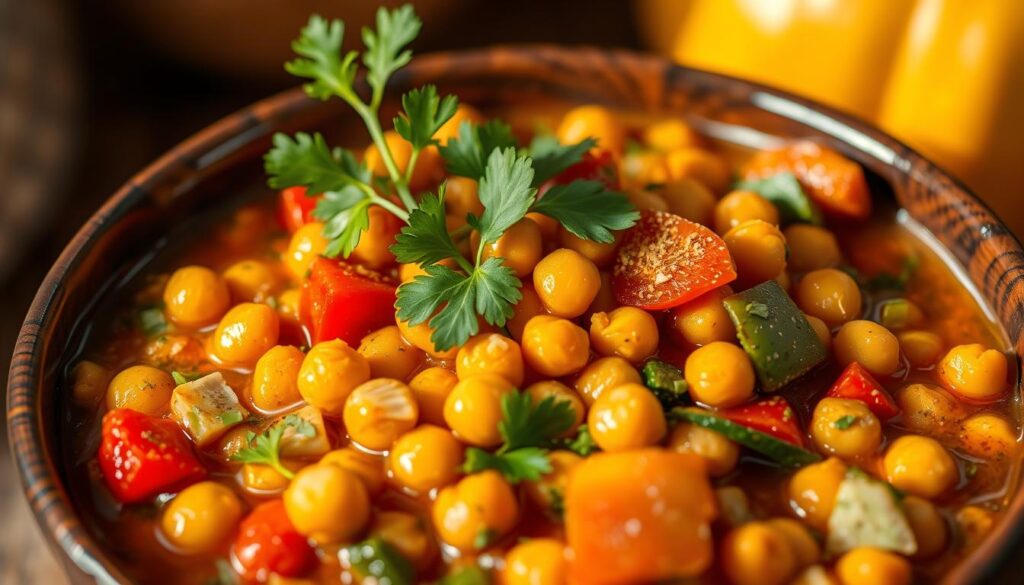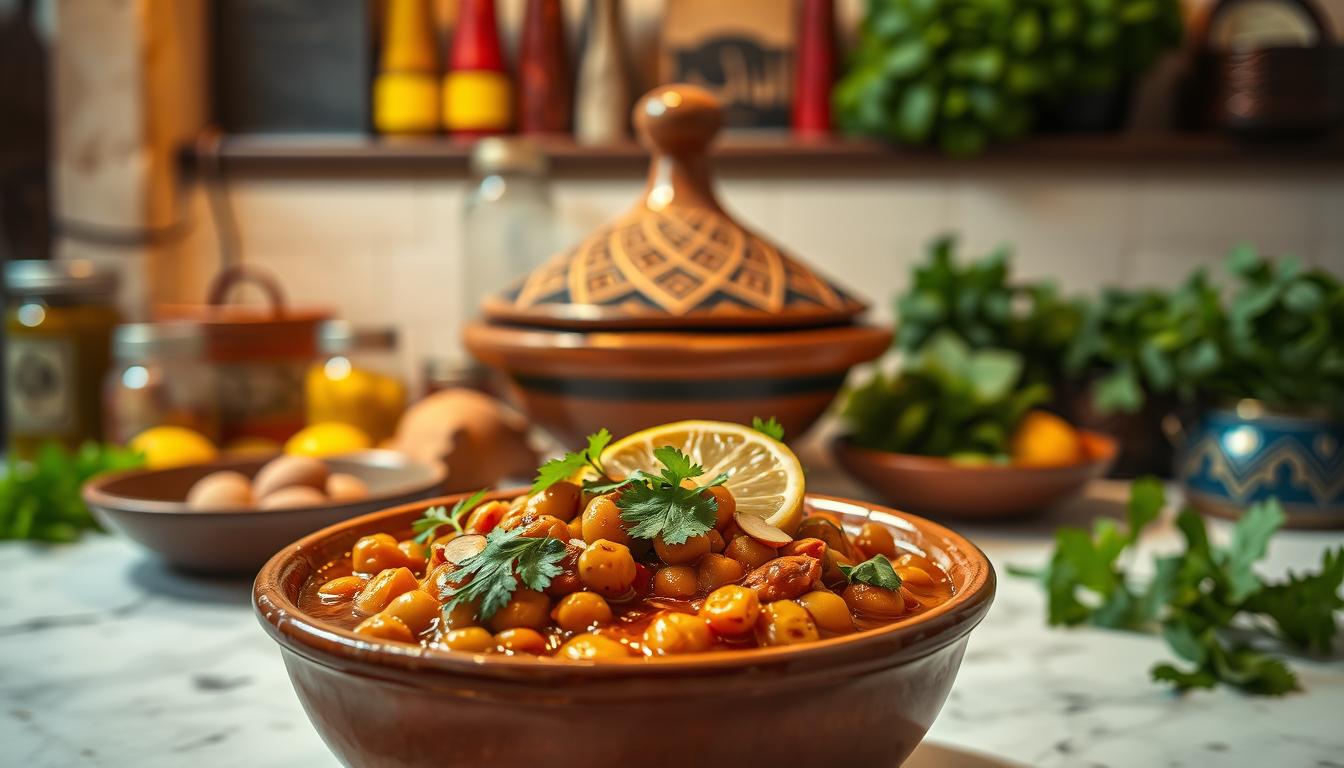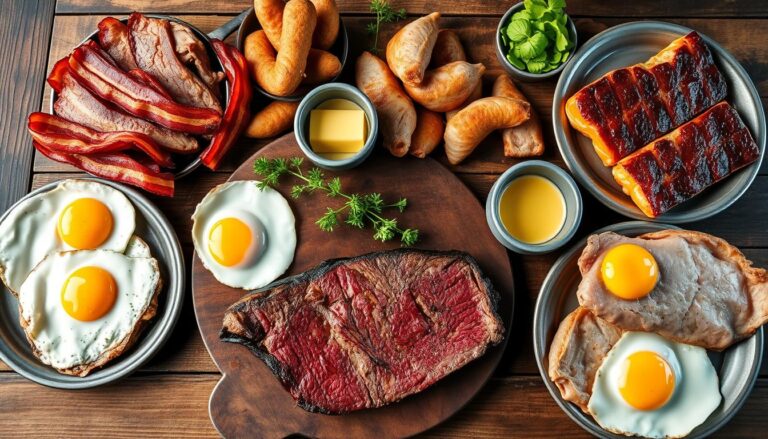Delicious Moroccan Chickpea Stew: A Comforting Meal
Imagine a warm, comforting meal that wraps you in a cozy blanket on a chilly evening. Moroccan cuisine is renowned for its rich flavors and nourishing dishes, and the Chickpea Stew is a perfect example. This hearty stew is a staple in many cultures, providing sustenance and comfort.
The Chickpea Stew is more than just a meal; it’s an experience. It’s a dish that brings people together, filling the air with the aroma of comforting spices. As you explore this recipe, you’ll discover the rich cultural heritage behind it.
Key Takeaways
- Discover the rich flavors of Moroccan cuisine through this comforting Chickpea Stew.
- Learn about the cultural significance of this nourishing dish.
- Explore the recipe and its variations to suit your taste.
- Understand the importance of chickpeas in creating a hearty stew.
- Experience the warmth and comfort of a homemade meal.
The Rich Heritage of Moroccan Cuisine
At the heart of Moroccan cuisine lies a blend of traditional Berber, Arabic, and Mediterranean flavors. This unique fusion is a result of Morocco’s strategic geographical position, which has made it a crossroads of cultural exchange for centuries.
The Influence of Berber, Arabic, and Mediterranean Cultures
Moroccan cuisine is deeply influenced by its Berber heritage, evident in the use of local ingredients and traditional cooking methods. Arabic cuisine has contributed significantly to the rich flavor profiles and the use of spices, while Mediterranean diet principles have introduced freshness and simplicity to the dishes. This blend creates a distinctive culinary identity that is both flavorful and aromatic.
The Significance of Stews in Moroccan Food Tradition
Stews, or “tagines,” hold a special place in Moroccan cuisine. They are not just a meal but a way of bringing people together. Traditionally cooked in a clay pot with a conical lid, stews are simmered slowly to develop deep, complex flavors. The communal aspect of sharing a stew is central to Moroccan hospitality, making stews a cornerstone of the country’s food culture.
The rich heritage of Moroccan cuisine is a testament to the country’s history and cultural diversity. Understanding these influences enhances the appreciation of dishes like the Moroccan Chickpea Stew, revealing the depth of tradition behind every flavorful bite.
Exploring the Authentic Moroccan Spiced Chickpea Stew
The rich aroma of Moroccan Spiced Chickpea Stew fills the kitchen, transporting you to the bustling markets of Marrakech. This beloved dish is a staple of Moroccan cuisine, known for its rich flavors and hearty ingredients. At its core, the stew is a masterful blend of spices, chickpeas, and vegetables, slow-cooked to perfection.
The Perfect Balance of Spices and Flavors
The secret to an authentic Moroccan Spiced Chickpea Stew lies in its perfect balance of spices. A blend of ground cumin, coriander, cinnamon, and turmeric creates a warm, aromatic flavor profile that is both comforting and exotic. The addition of fresh ingredients like garlic, ginger, and parsley adds depth and freshness to the dish. The key is to achieve a harmonious balance between these spices and the chickpeas, allowing each component to enhance the others.
To achieve this balance, it’s essential to start with a robust spice blend. Ras el hanout, which translates to “head of the shop,” is a Moroccan spice mix that can include up to 30 different spices. This blend is the foundation of many Moroccan dishes, including the Spiced Chickpea Stew. By incorporating ras el hanout into your recipe, you’ll be able to capture the authentic flavors of Moroccan cuisine.
The Cultural Significance of This Beloved Dish
Moroccan Spiced Chickpea Stew holds significant cultural importance in Morocco, where it’s often served during special occasions and family gatherings. The stew is more than just a meal; it’s a symbol of hospitality and community. In Moroccan culture, sharing a meal is a sign of respect and affection, and the Spiced Chickpea Stew is frequently at the center of these gatherings.
The dish also reflects the country’s rich culinary heritage, influenced by Berber, Arabic, and Mediterranean traditions. The use of chickpeas, for example, is a testament to the Mediterranean diet’s impact on Moroccan cuisine. By exploring the cultural significance of this stew, we gain a deeper appreciation for the role it plays in Moroccan society and the values it represents.
Essential Ingredients for an Authentic Recipe
To create an authentic Moroccan Spiced Chickpea Stew, it’s crucial to start with the right ingredients. The dish is a symphony of flavors and textures, all of which are derived from its core components.
The Foundation: Chickpeas and Their Preparation
Chickpeas are the star of the stew, providing protein, fiber, and a satisfying texture. The way they are prepared can significantly impact the final dish.
Dried vs. Canned Chickpeas
While canned chickpeas offer convenience, dried chickpeas soaked overnight and cooked from scratch can enhance the stew’s flavor and texture. Canned chickpeas are a quicker alternative but may contain added salt.
Soaking and Pre-cooking Methods
Dried chickpeas require soaking, typically overnight, before being drained and rinsed. They can then be cooked until tender, either on the stovetop or using a pressure cooker, to reduce cooking time.
The Aromatic Spice Blend
The aromatic spice blend is what gives the Moroccan Spiced Chickpea Stew its distinctive flavor. A mix of ground spices creates a warm, inviting aroma.
Essential Spices: Cumin, Coriander, and Cinnamon
Cumin, coriander, and cinnamon are the backbone of the spice blend, offering earthy, slightly sweet, and warm notes. These spices are fundamental to Moroccan cuisine.
Optional Flavor Enhancers: Saffron, Ginger, and Harissa
For added depth, saffron can introduce a luxurious, subtle earthiness, while ginger adds a spicy warmth. Harissa can be used to add a spicy kick for those who prefer it.
Fresh Produce and Additional Components
Fresh vegetables and other components add freshness, texture, and variety to the stew. Onions, garlic, tomatoes, and sometimes bell peppers or zucchini, contribute to the stew’s complexity.
The use of fresh produce not only enhances the flavor but also increases the nutritional value of the dish. A variety of vegetables can be used, making the stew versatile and adaptable to seasonal availability.
By carefully selecting and preparing these essential ingredients, you can create a rich and flavorful Moroccan Spiced Chickpea Stew that is both nourishing and delicious.
Kitchen Equipment You’ll Need
Before diving into the recipe, let’s explore the necessary kitchen equipment for cooking Moroccan Spiced Chickpea Stew. Having the right tools can make a significant difference in the preparation and cooking process.
Traditional Tagine vs. Modern Cooking Vessels
A traditional tagine is a clay pot with a conical lid, originating from North Africa. It’s ideal for slow-cooking stews like our Moroccan Spiced Chickpea Stew. However, not everyone has a tagine in their kitchen. Modern alternatives include Dutch ovens or heavy pots with lids, which can replicate the slow-cooking effect. As
“The tagine’s unique design allows for the condensation of steam, which then falls back onto the food, creating a moist and flavorful dish.”

Essential Tools for Preparation and Serving
In addition to the main cooking vessel, you’ll need some basic kitchen tools. These include a large mixing bowl for preparing ingredients, a sharp knife for chopping vegetables, and a wooden spoon or silicone spatula for stirring. For serving, consider using a large, shallow bowl or a tagine plate to present your stew authentically.
By having the right kitchen equipment, you’ll be well on your way to creating a delicious and authentic Moroccan Spiced Chickpea Stew.
Step-by-Step Cooking Process
To create an authentic Moroccan Spiced Chickpea Stew, one must start with a deep understanding of the aromatic base that forms its foundation. This initial step is crucial in developing the rich flavors that characterize this beloved dish.
Preparing the Aromatic Base
The aromatic base is a mixture of sautéed onions, garlic, and a blend of spices that are cooked together to create a deep, rich flavor profile. Begin by heating a couple of tablespoons of olive oil in a large pot over medium heat. Add finely chopped onions and cook until they are translucent, stirring occasionally to prevent burning. Next, add minced garlic and cook for another minute, stirring constantly to avoid bitterness.
Once the onions and garlic are ready, it’s time to add the aromatic spices. This typically includes a mix of ground cumin, coriander, cinnamon, and turmeric, among others. The key is to cook these spices for a minute or until they are fragrant, which helps to release their essential oils and intensify their flavors.
Adding and Cooking the Main Ingredients
With the aromatic base prepared, the next step is to add the main ingredients, starting with chickpeas, diced tomatoes, and vegetable broth. Chickpeas should be drained and rinsed if using canned, or soaked and cooked if using dried. The diced tomatoes add a burst of freshness, while the vegetable broth helps to achieve the desired consistency.
Bring the mixture to a boil, then reduce the heat to low and let it simmer. This is where the flavors meld together, creating a harmonious and savory stew. It’s essential to stir occasionally to prevent the ingredients from sticking to the bottom of the pot.
Simmering to Perfection: Timing and Technique
The final step in the cooking process is simmering the stew to perfection. This requires patience, as the stew needs to cook slowly over low heat for at least 30 minutes. The simmering time allows the flavors to deepen and the chickpeas to absorb the spices fully.
To achieve the perfect consistency, adjust the cooking time based on the tenderness of the chickpeas and the thickness of the stew. Some prefer a thicker stew, while others like it more brothy. The simmering technique is key to achieving the desired outcome, making the stew a comforting and satisfying meal.
Variations of Moroccan Chickpea Stew
The beauty of Moroccan Chickpea Stew lies in its variations, from regional twists to dietary adaptations. This beloved dish is not static; it evolves based on geographical location, personal preferences, and dietary needs.
Regional Differences Within Morocco
Morocco is a country with diverse culinary traditions, and the Chickpea Stew is no exception. Different regions add their unique touch to the recipe. For instance, the stew might be spicier in the south or include different vegetables based on local produce.
| Region | Unique Ingredient | Flavor Profile |
|---|---|---|
| Marrakech | Preserved Lemons | Tangy, Salty |
| Fez | Olives | Briny, Savory |
| Ouarzazate | Fresh Herbs | Bright, Aromatic |
Vegetarian and Vegan Adaptations
For vegetarians and vegans, the Moroccan Chickpea Stew is a staple. It’s naturally free from animal products, making it an excellent option. Some adaptations include using vegetable broth instead of chicken broth and ensuring the spices are free from animal-derived ingredients.
Adding Protein: Meat, Poultry, or Fish Options
While the stew is traditionally vegetarian, adding protein is a common variation. Some popular options include lamb, chicken, or even fish for a coastal twist. The key is to cook the protein until it’s tender before adding the chickpeas and vegetables.
For example, adding lamb shoulder can enrich the stew with a deeper flavor, while chicken breast can provide a leaner protein source. Fish like cod or tilapia can be added towards the end of cooking to prevent overcooking.
Serving Suggestions and Traditional Accompaniments
When serving Moroccan Chickpea Stew, there are several traditional and modern accompaniments to consider. The right sides can enhance the flavors and overall dining experience.
Authentic Moroccan Sides: Couscous and Flatbreads
In Moroccan cuisine, couscous is a staple that pairs perfectly with the stew. The fluffy texture and mild flavor of couscous help balance the rich flavors of the stew. Khobz, a traditional Moroccan flatbread, is another popular accompaniment. It’s often used to scoop up the stew, making the meal more interactive and enjoyable.
Modern Pairing Ideas for American Kitchens
For those looking to incorporate modern twists, there are several options that work well in American kitchens. Crusty whole grain bread or quinoa salad can serve as great alternatives or additions to traditional couscous. For a lighter option, a simple green salad with a citrus vinaigrette can cut through the richness of the stew.
| Traditional Accompaniments | Modern Alternatives |
|---|---|
| Couscous | Quinoa Salad |
| Khobz (Moroccan Flatbread) | Whole Grain Bread |
| Green Salad with Citrus Vinaigrette |
Health Benefits of This Nourishing One-Pot Meal
The Moroccan Spiced Chickpea Stew is not only a flavorful dish but also a powerhouse of nutrition. This hearty stew combines the goodness of chickpeas, vegetables, and a blend of spices, making it a healthy and satisfying meal option.

Protein and Fiber Content from Chickpeas and Vegetables
The stew is rich in protein and fiber, thanks to the chickpeas and variety of vegetables used. Chickpeas are an excellent source of plant-based protein, making this dish ideal for vegetarians and vegans. The fiber content helps in maintaining a healthy digestive system and can aid in managing cholesterol levels.
Nutritional Highlights:
- High in plant-based protein
- Rich in dietary fiber
- Good source of essential vitamins and minerals
Antioxidants and Anti-inflammatory Properties of Spices
The blend of spices in the Moroccan Spiced Chickpea Stew adds not just flavor but also significant health benefits. Spices like cumin, coriander, and turmeric are known for their antioxidant and anti-inflammatory properties. These help in protecting the body against free radicals and reducing inflammation, which can contribute to various chronic diseases.
“The use of spices in cooking is not just about adding flavor; it’s also about enhancing the nutritional value of the meal.”
How This Stew Fits into a Balanced Diet
Incorporating the Moroccan Spiced Chickpea Stew into your diet can be a great way to maintain a balanced intake of nutrients. It’s a one-pot meal that provides a good mix of protein, healthy carbohydrates, and fiber, along with essential vitamins and minerals. This stew can be a regular feature in a healthy eating plan, supporting overall well-being and satisfaction.
Tips for a Balanced Meal:
- Serve with whole grain couscous or bread for added fiber
- Add a side of fresh salad for extra vitamins
- Use a variety of colored vegetables to maximize nutrient intake
Expert Tips for the Perfect Moroccan Chickpea Stew
The key to a delicious Moroccan Chickpea Stew lies in understanding a few expert tips and tricks. To make this dish truly shine, it’s essential to pay attention to the details that elevate it from good to great.
Common Mistakes to Avoid
One common mistake is not soaking the chickpeas long enough, leading to an unpleasant texture. Another is over-spicing, which can overpower the delicate flavors of the other ingredients. To avoid these pitfalls, ensure you soak chickpeas overnight and taste as you go, adjusting the spices accordingly.
Make-Ahead, Freezing, and Reheating Advice
Moroccan Chickpea Stew is an excellent candidate for make-ahead cooking. It can be refrigerated for up to 3 days or frozen for up to 3 months. When reheating, do so gently over low heat, adding a bit of water or broth if the stew has thickened too much.
Adjusting Flavors and Consistency
The beauty of this stew lies in its adaptability. For a thicker consistency, simmer with the lid off; for a thinner, reduce the amount of tomato paste or add more broth. Adjust the seasoning by adding more spices or a squeeze of lemon juice to brighten the flavors.
| Tip | Description | Benefit |
|---|---|---|
| Soak Chickpeas Overnight | Improves texture | Better mouthfeel |
| Taste and Adjust Spices | Balances flavors | Enhanced flavor profile |
| Gentle Reheating | Preserves flavors and texture | Retains dish quality |
Conclusion
The Moroccan Spiced Chickpea Stew is a true reflection of Morocco’s rich culinary heritage, blending the country’s Berber, Arabic, and Mediterranean influences into a deliciously comforting meal. This nourishing one-pot dish is not only a treat for the taste buds but also provides numerous health benefits, making it a perfect addition to a balanced diet.
By following the steps outlined in this article, you can recreate this authentic Moroccan recipe in the comfort of your own kitchen. The combination of aromatic spices, tender chickpeas, and fresh produce creates a flavorful stew that is sure to become a favorite. Whether you’re looking for a comforting meal on a chilly evening or a healthy, satisfying dish to share with friends and family, the Moroccan Spiced Chickpea Stew is an excellent choice.
As you explore the world of Moroccan cuisine, this stew is a great place to start. With its rich flavors and nourishing ingredients, it’s a recipe conclusion that will leave you wanting more. So, gather your ingredients, simmer the stew to perfection, and indulge in the warm, aromatic flavors of Morocco.







